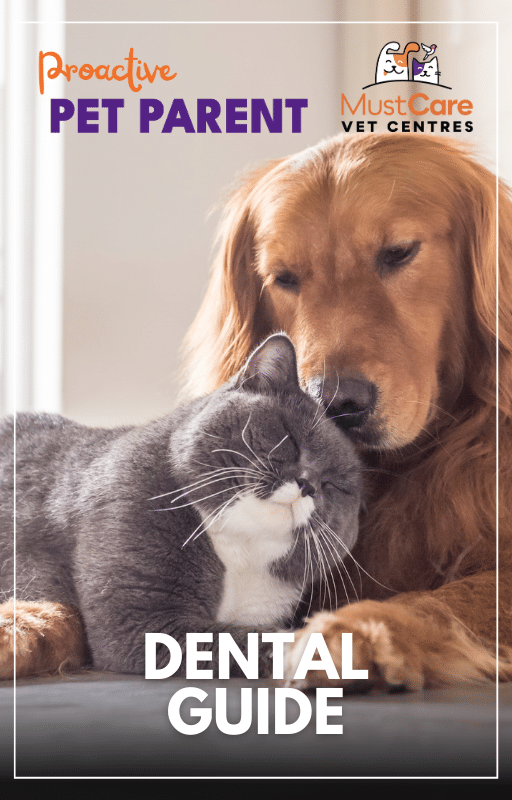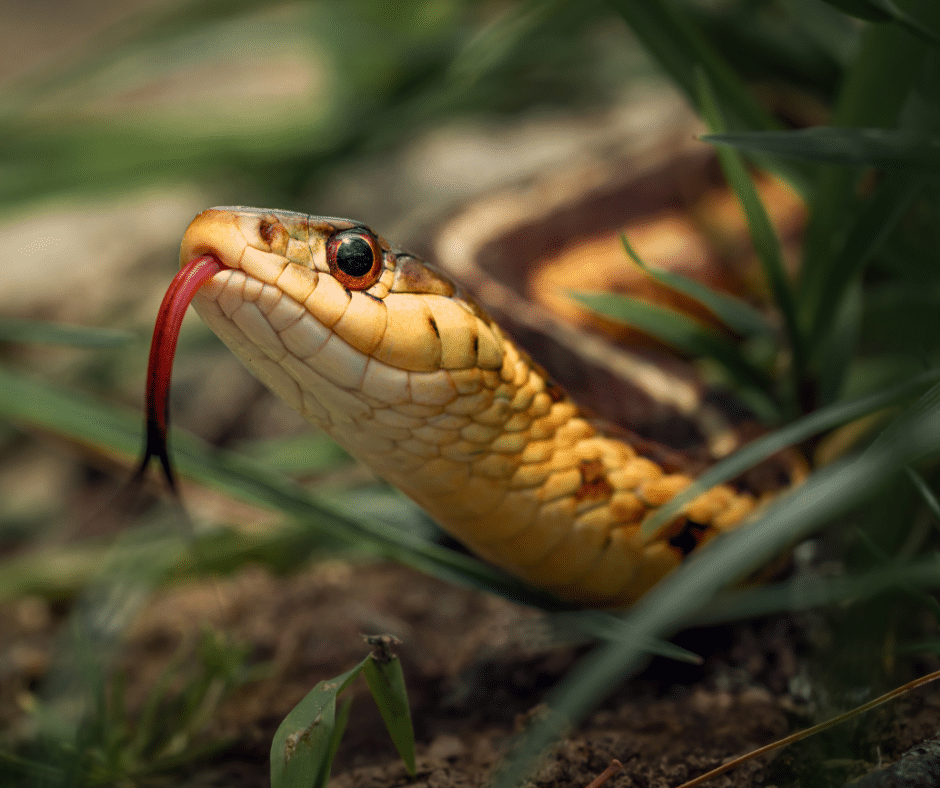Share This Blog With Other Pet Parents!
Know the Signs and Symptoms of Snake Bites in Pets
Understanding the risks and being prepared is crucial for every pet owner. Snake bites, are exceedingly common in South-East Queensland, are a serious concern that can pose significant health risks to our furry companions. This article offers comprehensive insights into identifying and managing snake bites in pets.
What you’ll learn from this blog:

For all you need to know, download our
FREE Dental Guide
This blog is part of our Proactive Pet Parent series! This is just the beginning… To see more blogs, click here! Better yet, sign-up to our newsletter to receive these directly to your inbox each month.
Sign-up To The Proactive Pet Parent Newsletter
Identifying Different Types of Snake Bites: Venomous vs. Non-Venomous Snakes
Understanding the differences between venomous and non-venomous snake bites is vital for the safety and well-being of your pets. Here’s how to distinguish between the two:
- Venomous snakes typically leave two distinct puncture marks made by their fangs. In contrast, non-venomous snake bites may look like a series of small scratches or lacerations.
- Venomous bites often result in immediate and noticeable symptoms. These can include severe pain at the bite site, swelling, redness, and rapid onset of systemic symptoms such as difficulty breathing, weakness, and altered mental state. Non-venomous bites may cause pain and swelling but generally do not lead to severe systemic reactions.
- If it’s safe to do so, take note of the snake’s appearance. Venomous snakes often have triangular heads, elliptical pupils, and noticeable colour patterns. However, identifying snakes can be challenging and dangerous, so prioritising safety is essential.
- Watch for signs of distress in your pet. A pet bitten by a venomous snake may exhibit signs of nausea, vomiting, salivation, lethargy, and shock. With non-venomous bites, these symptoms are less likely, although pain and fear reactions may occur.
- Venomous snake bites can cause significant local tissue damage. You may observe rapid swelling, bruising, and possibly bleeding or discharge from the wound site. Non-venomous bites are less likely to cause severe local reactions.
Immediate Actions – What To Do If Your Pet Is Bitten By A Snake
Regardless of the type, any snake bite to your pet warrants prompt veterinary care. Here are some steps you should take immediately:
- Keep Calm and Secure Your Pet: Stay calm and gently restrain your pet to prevent further injury.
- Avoid Home Remedies: Do not attempt to suck out venom, apply tourniquets, or cut the wound. These actions can do more harm than good, and can even harm you.
- Seek Veterinary Care Immediately: Time is critical, especially for venomous bites. Contact your veterinarian or the nearest emergency veterinary clinic right away, even if you think the snake is non-venomous.
- Provide Information: If you have any information about the snake, share it with the veterinarian. However, do not risk further injury or harm yourself by trying to capture or kill the snake.
Keep your pets away from known snake habitats and always supervise them while outdoors. By being informed and prepared, you can significantly reduce the risks associated with snake bites.
Signs of Snake Bites in Pets
After a snake bite, pets may exhibit various physical symptoms that warrant immediate attention.
Here’s what to look for:
- Swelling: One of the most common signs of a snake bite is swelling, which can occur rapidly at the bite site. The swelling can be significant, especially in venomous snake bites, and may spread to surrounding areas.
- Redness: Look for redness around the bite site. This may accompany swelling and indicates an inflammatory response by the pet’s body to the injury.
- Pain: Pets may show signs of pain, which can be evident through whining, yelping, limping, or reluctance to be touched near the bite area.
- Collapse: Dogs may collapse when initially bitten, and then spring back up and continue on as normal. This is the number one sign of snake bite so if you see this happen, get your dog to the vet immediately.
Along with physical symptoms, behavioral changes in your pet can also indicate a snake bite:
- Agitation: A pet that has been bitten may become unusually agitated. They might pace, seem restless, or be unable to settle down. This agitation can be due to pain or the effects of venom in the case of venomous bites.
- Fear: Your pet might exhibit signs of fear or anxiety. This could manifest as hiding, cowering, or showing reluctance to go near the area where the bite occurred.
- Confusion: In more severe cases, especially with venomous snake bites, pets can appear confused or disoriented. This could be a result of the toxic effects of snake venom on their system.

First Aid for Snake Bites in Pets
When your pet suffers a snake bite, immediate action can be critical. Here’s what you can do as first aid:
- Remain Calm: Keeping calm is essential. Your pet can pick up on your emotions, and staying composed will help keep them calm as well.
- Limit Movement: Restrict your pet’s movement to slow the spread of venom. Carry your pet rather than allowing them to walk if it’s safe to do so.
- Keep the Bite Below Heart Level: If possible, keep the part of your pet’s body that was bitten below the level of their heart. This can help slow the spread of venom.
- Remove Collars or Constricting Items: If the bite is near the neck or body, remove collars or any other constricting items to allow for swelling.
- Do Not Apply a Tourniquet: Avoid using tourniquets or trying to cut or suck out the venom, as these actions can cause more harm.
- Wash the Wound: Gently clean the bite area with mild soap and water if it’s safe to do so.
Seeking professional veterinary care promptly is crucial, regardless of whether the snake is venomous or not. Here’s when to seek help:
- Immediately After the Bite: Don’t wait to see how symptoms develop. Seek veterinary care immediately after a suspected snake bite.
- Even If Symptoms Seem Mild: Sometimes, symptoms may not appear severe initially but can worsen rapidly. It’s better to be cautious and get your pet checked.
- If You Identify the Snake as Venomous: If you know or suspect the snake is venomous, treat the situation as an emergency and seek veterinary help without delay.
- If Your Pet Shows Any Symptoms: Symptoms like swelling, pain, redness, agitation, or confusion are all indicators that your pet needs veterinary attention.
Medical Interventions for Snake Bites
Effective treatment of snake bites in pets requires prompt and appropriate medical interventions. Here’s what the treatment typically involves:
- Thorough Examination: Upon arrival at the veterinary clinic, your pet will receive a thorough physical examination. This helps assess the severity of the bite and the general health of your pet.
- Blood Tests: Blood tests may be conducted to evaluate the extent of venom’s impact on your pet’s system, especially for venomous snake bites. These tests can check for clotting disorders, organ function, and other systemic effects of the venom.
- Pain Relief: Managing pain is a crucial aspect of treatment. Your veterinarian will administer appropriate pain relief medications to make your pet more comfortable.
- Anti-Venom: For venomous snake bites, anti-venom is often the most effective treatment. It neutralises the snake venom, reducing its harmful effects. The sooner the anti-venom is administered, the better the outcome generally is.
- Intravenous Fluids: IV fluids may be given to maintain blood pressure and support kidney function, especially if your pet is showing signs of shock or dehydration.
- Wound Care: The bite wound will be cleaned and treated to prevent infection. In some cases, surgery may be required to address severe tissue damage.
- Monitoring and Supportive Care: Continuous monitoring and supportive care are vital, especially in the first 24 to 48 hours after the bite, to ensure there are no delayed complications.
Rehabilitation And Recovery From Snake Bites
The recovery process and prognosis can vary depending on several factors:
- Type of Snake: Recovery largely depends on whether the snake was venomous and the type of venom involved.
- Time to Treatment: Early intervention typically results in a better prognosis. Delays in treatment can lead to more severe complications.
- Severity of the Bite: Severe bites, especially those involving significant venom injection, can have a more complicated recovery process.
- Pet’s Overall Health: Young, healthy pets often have a better chance of a full recovery compared to older pets or those with pre-existing health conditions.
- Rehabilitation: Some pets may require a period of rehabilitation, especially if the bite caused significant muscle or nerve damage.
- Follow-up Care: Regular follow-up appointments may be necessary to monitor your pet’s recovery and address any long-term effects of the bite.
Monitoring Recovery: What to Expect
After your pet has received initial treatment for a snake bite, long-term care and monitoring become crucial. Here’s what you can expect during the recovery process:
- Regular Veterinary Check-Ups: Frequent follow-up visits to the veterinarian are important to monitor your pet’s recovery. These check-ups may include blood tests, wound inspections, and assessment of any ongoing symptoms.
- Observation for Late-Onset Symptoms: Some effects of a snake bite, particularly from venomous snakes, can manifest days or even weeks later. Be vigilant for any changes in behaviour, appetite, or general health.
- Wound Healing: Keep an eye on the wound site for signs of infection or delayed healing. Proper wound care as advised by your veterinarian is essential.
- Managing Pain and Discomfort: Continue to manage your pet’s pain as prescribed. This may include medications or specific comfort measures at home.
- Nutritional Support: A balanced diet and adequate hydration are crucial for recovery. Your veterinarian may recommend dietary adjustments to support healing.
Rehabilitation
The rehabilitation phase is critical, especially for pets that have suffered significant effects from the snake bite:
- Physical Therapy: If your pet has sustained muscle or nerve damage, physical therapy may be recommended. This can include exercises to maintain muscle strength and flexibility.
- Mental and Emotional Support: Pets can experience anxiety or stress following a traumatic event like a snake bite. Provide a calm, comforting environment, and consider engaging in gentle play or relaxation techniques.
- Activity Modifications: Depending on the severity of the bite, you may need to modify your pet’s activity levels. Gradually reintroduce exercise as recommended by your veterinarian.
- Medication Adherence: Ensure that you adhere strictly to any medication schedules, including pain relief and antibiotics, as prescribed by your veterinarian.
- Long-Term Monitoring: Some pets may experience long-term effects, such as sensitivity at the bite site or chronic pain. Regular veterinary check-ups can help manage these ongoing issues.

